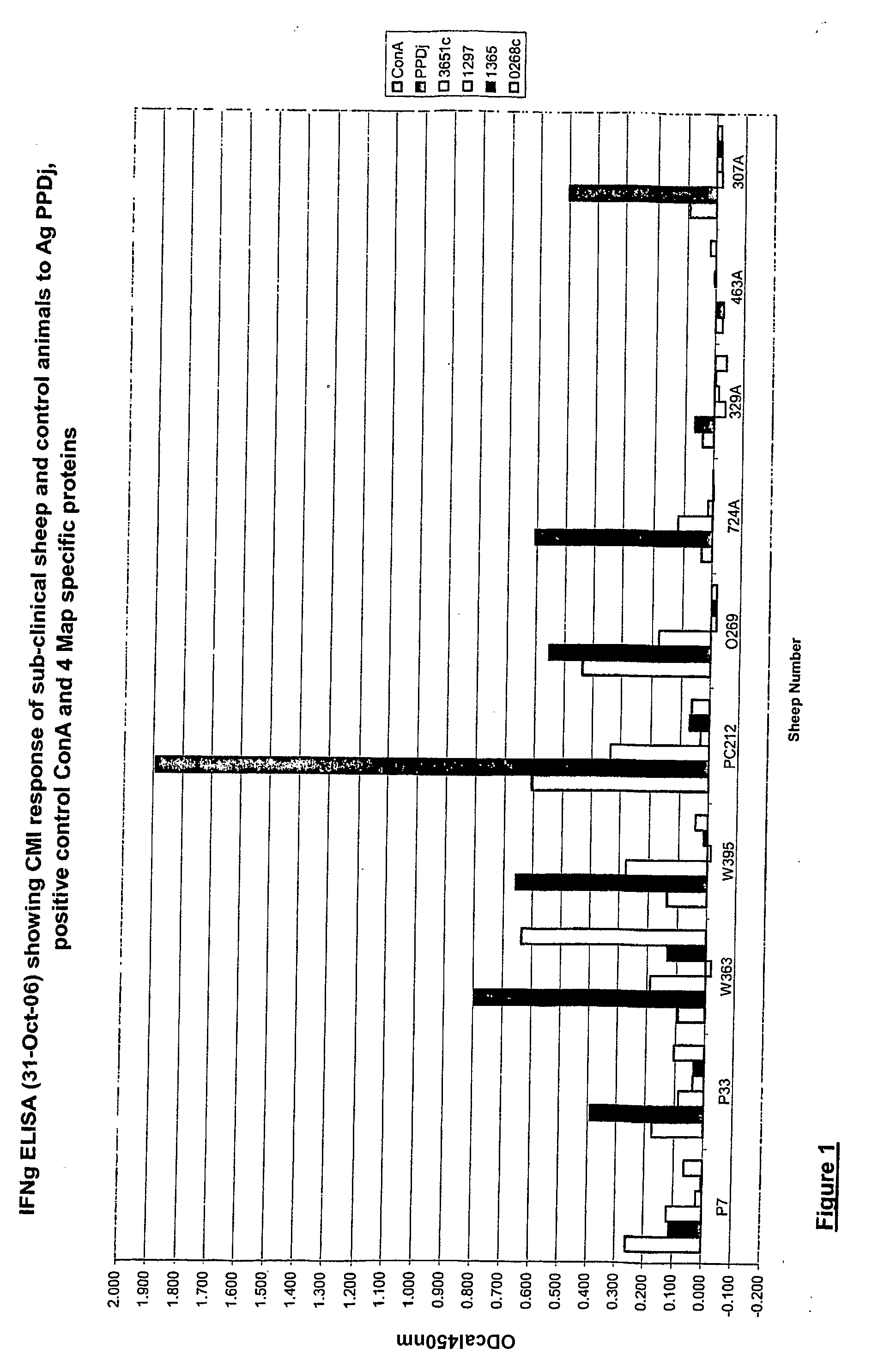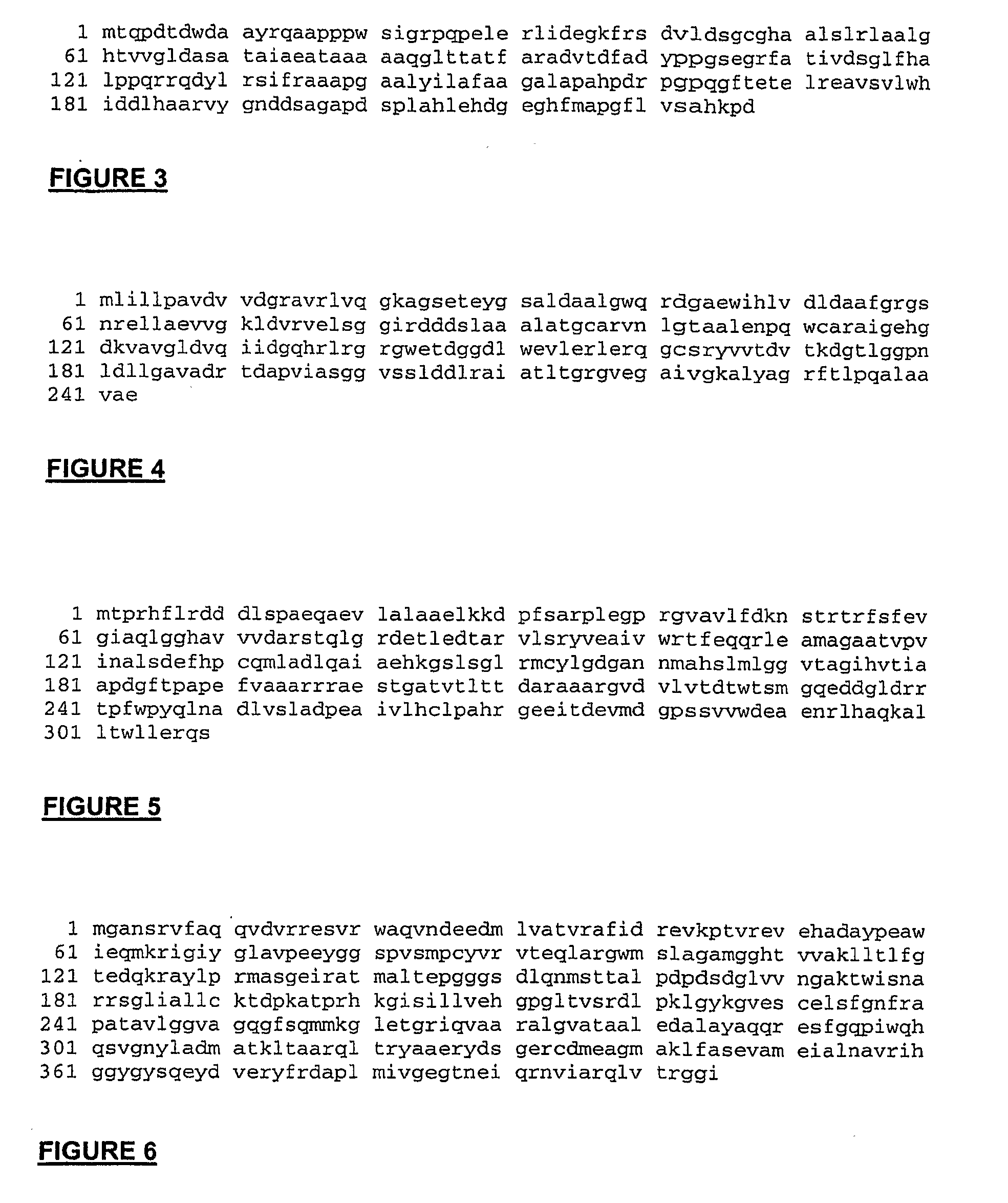Mycobacterial infections
a technology for mycobacterial infections and host organisms, applied in the field of mycobacterial infections, can solve the problems of increasing the cost of control, monitoring and diagnosis, reducing the productivity of adult animals, and increasing the cost of control, monitoring and maintenance. , to achieve the effect of reducing the degree of map colonisation in a host organism and/or the severity
- Summary
- Abstract
- Description
- Claims
- Application Information
AI Technical Summary
Benefits of technology
Problems solved by technology
Method used
Image
Examples
example 1
Proteomic Identification of Map-Specific Proteins
Map-specific antigens were identified by comparison of the proteomes of Map and IS901+M.a.avium, which is the mycobacterium most closely related to Map and capable of infecting animals. The rational for this approach was that comparison of the proteomes of the two organisms would identify subspecies-specific proteins, including the products of differential gene regulation that would not be detected by a comparative genomics approach. In order to perform a comparison of IS901+ M.a.avium and Map, it was necessary first to undertake significant development work to optimise and standardise the experimental and analytical procedures required. The standardized methods are detailed above. Since the proteome changes during the growth cycle, comparisons were made also between the proteomes obtained from the organisms at different stages in the growth cycle (both log and stationary phases were investigated).
On comparison of the proteomes, prote...
example 2
Recognition of the Map-Specific Proteins by the Cell-Mediated Immune Response of Infected Sheep
To determine whether any of the Map-specific proteins would be suitable for use in a cell-mediated immunity assay, it was crucial to determine if they were recognized by the cell-mediated immune response of Map-infected animals. In order to undertake these experiments, it was necessary to identify subclinically infected sheep that were mounting a cell-mediated response to Map. To identify such animals, 35 sheep from a known infected flock were screened using the whole blood Bovigam IFN-γ assay using PPD-J (from Map), PPD-A (from M.a. avium) and PPD-B (from M. bovis) as the stimulatory antigens. Concavalin A (ConA) was included as a mitogen control to assess the health status of the cells. Nine animals were identified as having a significant positive response to PPD-J and were selected for further investigation. Control animals were taken from a flock with no history of paratuberculosis and...
example 3
Enhanced Stimulation of Cytokine Production in Ovine Blood with Cocktails of Map-Specific Antigens
The sensitivity of immunoassays can often be increased by using a cocktail of antigens. In a small pilot experiment, the cell-mediated immune responses of two sheep subclinically infected with Map were measured in response to single antigen preparations and a cocktail of recombinant Map-specific proteins 3651c and 1365 as described above. The results are shown in FIG. 7. A combination of two Map-specific antigens stimulated an enhanced response in the Bovigam IFN-γ ELISA compared with the single antigen preparations although the magnitude of the response varied between sheep. Different combinations of the Map-specific recombinant antigens will need to be evaluated to determine the optimum mix for diagnostic assays.
PUM
| Property | Measurement | Unit |
|---|---|---|
| time | aaaaa | aaaaa |
| time | aaaaa | aaaaa |
| concentration | aaaaa | aaaaa |
Abstract
Description
Claims
Application Information
 Login to View More
Login to View More - R&D
- Intellectual Property
- Life Sciences
- Materials
- Tech Scout
- Unparalleled Data Quality
- Higher Quality Content
- 60% Fewer Hallucinations
Browse by: Latest US Patents, China's latest patents, Technical Efficacy Thesaurus, Application Domain, Technology Topic, Popular Technical Reports.
© 2025 PatSnap. All rights reserved.Legal|Privacy policy|Modern Slavery Act Transparency Statement|Sitemap|About US| Contact US: help@patsnap.com



